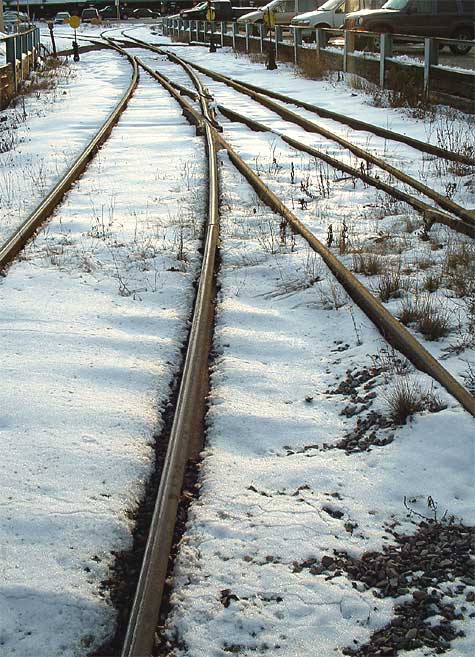Three way turnout, a trackwork rarity!
Finding a good three way can be difficult.
Having to run into Hamilton, Ontario yesterday to a supplier to re-fill some inventory, we decided to bring the cameras along and see what we could find. We being Ron and I. Being a model railroader, and being very interested in anything industrial, Hamilton is one of my favorite places. I lived there for about 4 years when I was a lot thinner.

7eventy 5ive divx Image Copyright (c) 2005 Tim Warris
There is a lot of heavy industry along the shore of lake Ontario and Burlington bay, with several steel mills and rusty places, and where there are steel mills and rusty places, there is lots of interesting railroading.
We managed to find, right along the side of the road, a great example of a three way turnout. These are quite rare, and to find one so close was a bit of a surprise. This is a lapped version, that is one turnout slightly forward of the other, and still in heavy use.
There were also several crossings nearby (where one track crosses another), which are also increasingly rare. We took some pictures of those too and I will add them over the next few days.
Click here for a link to a map showing the location of this turnout. The three way turnout will be right in the middle of the screen, on the North tail of the wye. It is pretty hard to spot in this image. By scrolling around the map you can see the massive amount of complex trackwork hidden in the industrial section of this great city.
Posted by: | 12-17-2005 | 12:12 PM
Posted in: Uncategorized
The Hamilton 3 way turnout might be identified as a ‘near’ 3 way turnout as it is composed of two turnouts that are interlaced. That makes it robust enough for an active industrial site whereas a ‘true’ 3 way turnout with the points longitudinally contacting at the same location would lack that sturdiness.
The picture exhibits a type of track componentry that appears to be limited to North American railways, and more
specifically, to railway yards with their slower speed limitations. That is the use of raised field side flanges acting on the field side of a railway wheel.
This permits the omission of check rails with the turnouts as seen in the image of those ‘self-guarded’ frogs. There is an additional example in the picture of raised field side fanges with the use of field side point protectors. Point protectors ‘protect’ the outside point rail of a turnout by preventing the outside wheel of a wheelset from contacting the face of the point rail when making movements in a diverting direction, particularly facing movements. Different methods are engineered but the type shown in the image uses a raised field side flange to nudge the wheelset away from the the outside point rail. The location of the two point protectors shown is on the right rail of the converged single track, with the raised flanges being visible.
As you are a model railroader, and particularliy dealing with track, have you done any trackwork involving raised field side flanges, such as the self-guarded frogs and field side point protectors seen in the image?
It can get even more exotic with multi-gauge track using extremely high frog numbers for an obtuse frog. I’m excluding fixed diamonds which have their limitations in the 1:8 to 1:9 range, but instead am referring only to fixed single obtuse frogs. Going from a point rail to an elbow rail in that circumstance almost never requires a check rail. But there are examples, for instance, in Switzerland using meter gauge nested inside standard gauge, no shared rail. When a shallow gauge separation occurs the obtuse frog is of such a high number that examples of field side check rails are incorporated in the point rail to elbow rail transition.